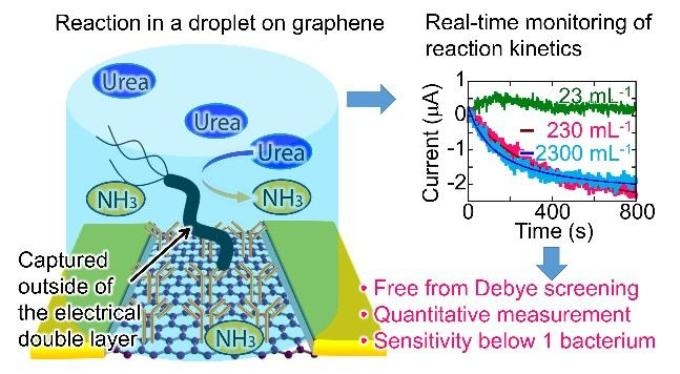Jun 21 2019
Biosensors, at present, are used in healthcare to keep a check on blood glucose; however, they also possess the capacity to detect bacteria. Osaka University scientists have created a new biosensor using graphene — a material made up of a one-atom-thick layer of carbon — to detect bacteria such as those that harm the stomach lining and that have been associated with stomach cancer.
 This is a schematic illustration of the study design and results. (Image credit - Osaka University)
This is a schematic illustration of the study design and results. (Image credit - Osaka University)
When the bacteria interact with the biosensor, chemical reactions are activated which are sensed by the graphene. To support detection of the chemical reaction products, the scientists used microfluidics to contain the bacteria in very tiny droplets near the surface of the sensor.
To make the bacteria to adhere, the scientists coated the graphene with antibodies, a common way of fastening bacteria to biosensor surfaces. However, though antibodies are very tiny (~10 nm), on the atomic scale, compared with the atom-thin layer of graphene, they are actually fairly bulky and large. While the bacteria interact with the antibodies, the graphene cannot sense those bacteria directly as the antibodies on its surface obstruct the signal; this signal blocking effect is known as Debye screening.
To defeat the Debye screening limitation, the scientists instead planned to track chemical reactions being carried out by the bacteria when exposed to certain chemicals, which they added to the minute water droplet. The chemicals generated in the reactions are much smaller than the antibodies and can slip between them without difficulty and reach the graphene surface. By only examining the bacteria in minute droplets produced through microfluidics, the bacteria and their reaction products can be kept near the surface of the graphene and the concentration of the reaction products can even be tracked for prolonged periods.
Our biosensor enables highly sensitive and quantitative detection of bacteria that cause stomach ulcers and stomach cancer by limiting its reaction in a well-defined microvolume.
Kazuhiko Matsumoto, Study Co-Author, Osaka University
The graphene sensing surface can feedback electrical signals that differ based on how much of the reaction product is present in the microdroplet and how rapidly it is collecting. These electrical signals can be used to compute the number of bacteria in the droplet. The graphene is arranged in a field effect transistor (FET) structure, the role of which is to radically increase the electrical detection signals from the graphene sensing surface.
"Our biosensor is essentially a mini laboratory on a graphene FET. This sensor demonstrates how two-dimensional materials such as graphene are getting closer to being applied in practical medical and healthcare applications," first author Takao Ono says.
The findings of the research can be used to develop a whole multitude of these "lab-on-a-graphene-FET" biosensors to detect various types of bacteria. The detection of minute concentrations of bacteria could be realized within 30 minutes; hence, this work signifies the possibility of faster diagnoses for possibly harmful bacteria in the days ahead.